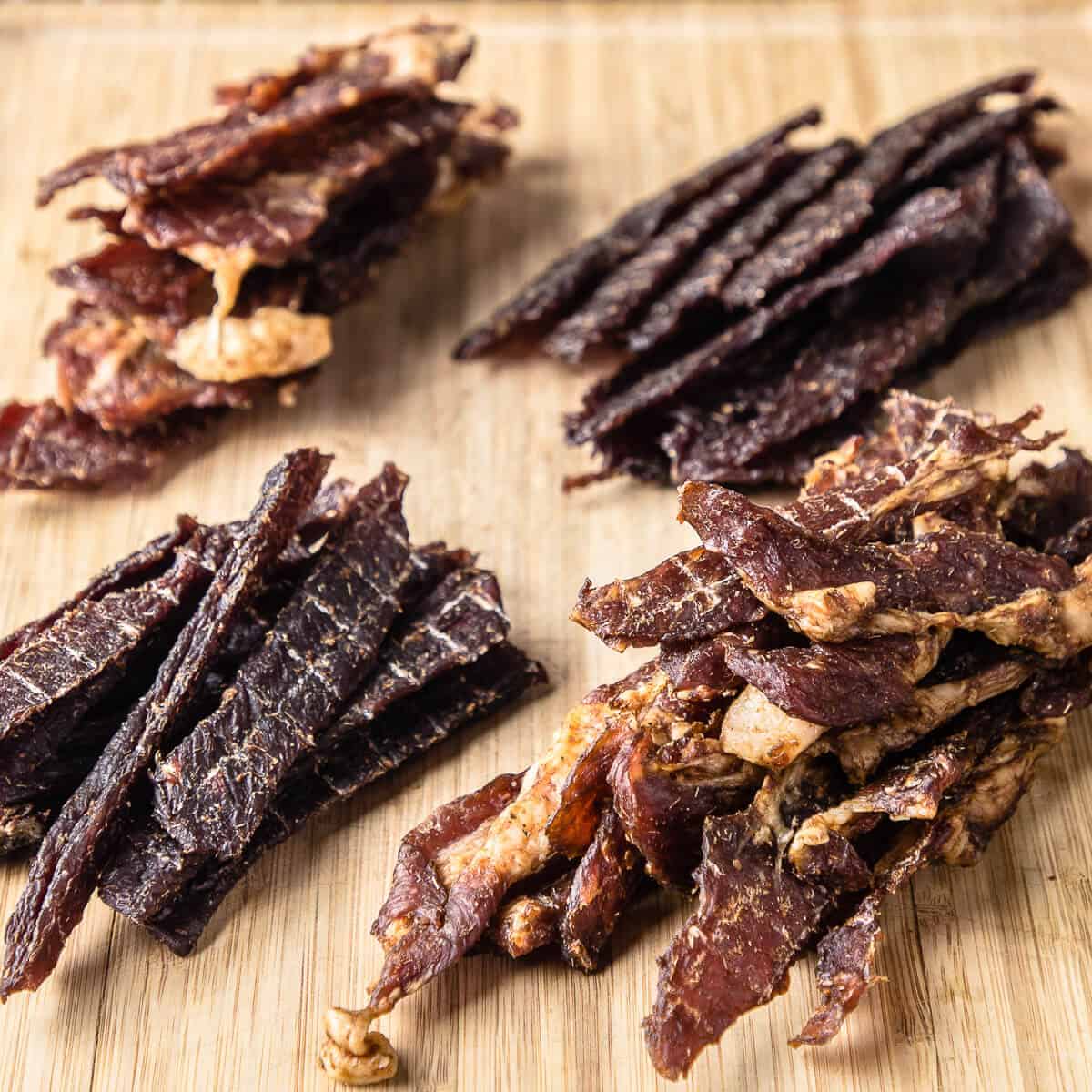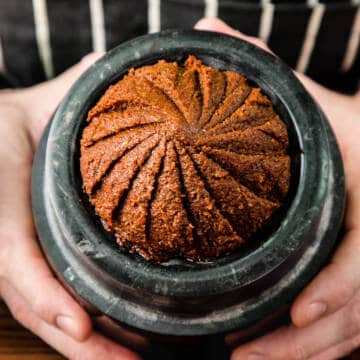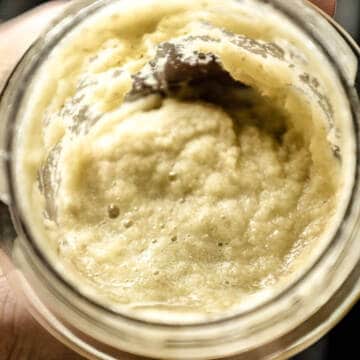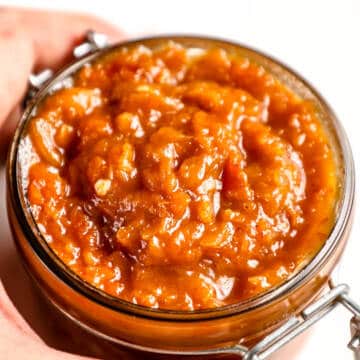Authentic Thai jerky is often made with beef or pork and sun dried in a naturally humid climate.
Both Thai beef jerky and Thai pork jerky are easy to make and dries quickly.
If you've had this in the street food markets in Thailand, you know it's a delicious snack that differs from the American version of jerky or dried meat.
We use our own homemade Thai red chilli paste as a marinade in this jerky recipe, but you can easily use a good store bought version.
The same recipe can also be used as an alternative marinade to cure biltong or bresaola.
Together with Thai spiced cashews, Thai jerky makes the perfect snack with an ice-cold beer.

Jump to:
Ingredients

- Meat - For the beef jerky, we use Eye of round, but you could use pretty much any cut of beef. Marbled beef makes the best jerky because of the higher fat content. For the pork jerky, I like using pork neck. It's tender and has lots of fat, which makes it ideal. You could also use pork belly.
- Curry paste - Red curry paste is the preferred choice. Make your own or use a Mae Ploy brand.
- Fish sauce - I ferment my own fish sauce by blending 1 kg of whole small fish with 1L of water and 20% salt. Ferment it for 1 year, and you have fish sauce. Alternatively, just buy fish sauce. It's an important ingredient for making Thai jerky, so don't skip it.
- Soy sauce - If you can find an unpasteurized soy sauce, use that as it has live enzymes which tenderizes the meat. Otherwise, just use a good brand of soy sauce.
- Sugar - Palm sugar or coconut sugar works great. Adds depth of flavour. Palm sugar and coconut palm sugar are different, by the way. They come from different palm. If you can't find it, just use regular sugar.
- Garlic - Fresh or dried. If using dried, use it sparingly.
- Salt - It's best to use non-iodized salt to avoid chemical aftertaste. It's faint, but important if you want to make the best jerky.
Instructions

- Slice the meat into trips or thin steaks. There are two ways of cutting it, so we'll show both.
- Cut across the grain of the meat. This is so that the jerky will be easily chewable.
- If you cut strips, set them aside. If you cut thin steak, beat them with a meat mallet until about ½ centimetre or ⅕th of an inch thick. Don't go and measure it, it's not that critical.
- Make the marinade and thorough mix with the meat. Cover with plastic wrap or a lid then let it marinade for at least 6 hours or up to 2 days in the fridge.

- Once marinated, it's time to dry. Place on meat hooks or lay flat on dehydrator trays.
- Hang in a well ventilated area away from flies or insects. If using a dehydrator, set it to 35 °C or 95 °F until you're happy with it. Could take anything from 12 to 24 hours. If you want it drier, let it go further.
- The perfect texture should be soft and slightly leathery.
- Store in the fridge in an airtight container or vacuum sealed.
Video
Drying options
- Curing chamber - You can cure the jerky in a curing fridge at a temperature of 18 °C or 64 °F and humidity set to 70%. This method takes longer and yields a very evenly cured result.
- Fridge - Fridge curing works well if you don't have any special equipment. Most fridges do a great job of drying out the air, with a relative humidity of about 30%. This can result in overly dried jerky quickly. Monitor it often. If using this drying method, make sure the fridge is spotless, and you're not touching the meat or storing other foods close to it. Logically, a bar fridge or extra drinks fridge is ideal, as you're not using it to store other foods.
- Outside - The most authentic way of doing it. In the sun, outside. Make sure to close it with fly nets and keep animals away.
- Dehydrator - This method is best for small restaurants or those living in urban areas with limited space. It works quick, and it works well, but take care not to overdry the jerky. Monitor often.
Storage instructions
Store airtight in a cool, dry place or in the fridge. It will keep for weeks in the fridge.
For longer storage, store in the freezer wrapped tightly to avoid freezer burn.
To preserve the flavour, it's best to vacuum seal in small portions.
Frequently asked questions
Yes, follow the same instructions, but replace the meat with either king oyster mushroom or cleaned fish fillet.
Not all types of jerky are suitable for eating with sticky rice. It's best to cut the jerky into smaller, bite-sized pieces before the marinating stage.
That way, once cured, you can easily wrap the sticky rice around the jerky and dip in a Thai dipping sauce. Simply consisting of lime juice, chilli, fish sauce, and palm sugar.
No, Thai jerky is not the cooked American version of jerky. It happens at a low temperature, and attempting to dry it in the oven will just cook the meat instead of cure it.
Useful equipment
Related recipes
This site contains affiliate links. I may earn a tiny commission on qualifying purchases at no extra cost to you. By bookmarking these links you help support the upkeep of this site.
If you found this post helpful or have learned something, comment, subscribe, and follow me on social platforms for more tasty recipes.
Recipe
Thai Beef And Pork Jerky (Video)
Ingredients
- 1 kilogram (2 ⅕ lb) Meat of choice - Note 1
- 150 grams (⅝ cups) Thai red curry paste - Note 2
- 100 grams (3/7 cups) Fish sauce
- 50 grams (⅕ cups) Soy sauce
- 15 grams (1 tablespoon) Salt - Non-iodized
- 100 grams (⅝ cups) Palm sugar - Note 3
- 15 grams (2 tablespoon) Garlic - Minced
Instructions
- Slice the meat into trips or thin steaks. There are two ways of cutting it, so we'll show both.
- Cut across the grain of the meat. This is so that the jerky will be easily chewable.
- If you cut strips, set them aside. If you cut thin steak, beat them with a meat mallet until about ½ centimetre or ⅕th of an inch thick. Don't go and measure it, it's not that critical.
- Make the marinade and thorough mix with the meat. Cover with plastic wrap or a lid then let it marinade for at least 6 hours or up to 2 days in the fridge.
- Once marinated, it's time to dry. Place on meat hooks or lay flat on dehydrator trays.
- Hang in a well ventilated area away from flies or insects. If using a dehydrator, set it to 35 °C or 95 °F until you're happy with it. Could take anything from 12 to 24 hours. If you want it drier, let it go further.
- The perfect texture should be soft and slightly leathery.
- Store in the fridge in an airtight container or vacuum sealed.
Video
Notes
- Meat, fish or veg - In this recipe I used beef eye of round and pork neck. You could use any cut of meat that does bot have loads of connective tissue. Well marbled meat gives the best results because the fat makes it juicer. You could also use fish, king oyster mushroom or even boiled carrots. When making it vegan, make sure to omit the fish sauce and use a vegan curry paste.
- Curry paste - Of course it's always best to make your own curry paste, but feel free to use a well known store-bought brand like Mae Ploy.
- Palm sugar - If you can find palm sugar, then use it. If not, simply use regular sugar. Honey is OK too, but use a mild honey. Strong favoured honey will interfere with the curry paste flavours.
- Curing chamber - You can cure the jerky in a curing fridge at a temperature of 18 °C or 64 °F and humidity set to 70%. This method takes longer and yields a very evenly cured result.
- Fridge - Fridge curing works well if you don't have any special equipment. Most fridges do a great job of drying out the air, with a relative humidity of about 30%. This can result in overly dried jerky quickly. Monitor it often. If using this drying method, make sure the fridge is spotless, and you're not touching the meat or storing other foods close to it. Logically, a bar fridge or extra drinks fridge is ideal, as you're not using it to store other foods.
- Outside - The most authentic way of doing it. In the sun, outside. Make sure to close it with fly nets and keep animals away.
- Dehydrator - This method is best for small restaurants or those living in urban areas with limited space. It works quick, and it works well, but take care not to overdry the jerky. Monitor often.


























Bernd
In ur video for the Thai jerky u marinade for 2 hrs
In the text it say 6hrs up to 2 days . What’s it gone be boy?
Really enjoy the way u present stuff. To the point, clear and simple enough. Good on you!
Charlé Visser
) doesn’t matter. Whatever you have time for. The meat will take up most the marinade almost straight away. So whether 2 hours or 24, the same amount of marinade will dry with the meat. However, if you have a tough piece of meat then it will benefit from the longer marinade slightly.